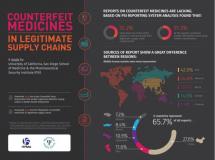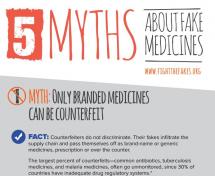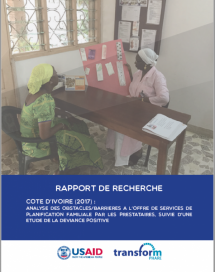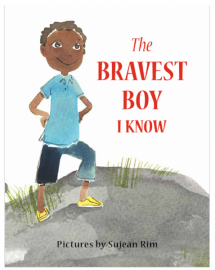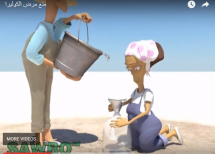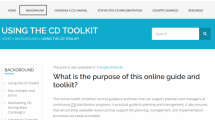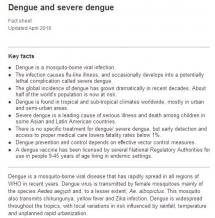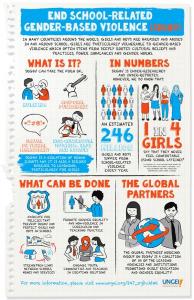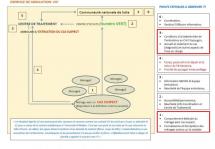Language: French
5 Myths about Fake Medicines
This infographic responds to the following myths:
- Only branded medicines can be counterfeit
- Only lifesstyle pills are faked
- Worst comes to worse, the pills just won’t work
- There are good quality faked medicines
- Fake medicines are easy to spot
Source: Fight the Fakes
Date of Publication: March 25, 2019
SIMILIAR RESOURCES
Tools
Examples
- Fake Medicines and Malaria
- Promoting Quality Malaria Medicines Through SBCC: An Implementation Kit
- Counterfeit Medicines in Legitimate Supply Chains
- Fake Medicines: Training for Action E-Learning Course
- Promoting Quality Malaria Medicine through Social and Behavior Change Communication
- SBCC for Malaria in Pregnancy: Strategy Development Guidance
- Zika and Pregnancy: Questions and Answers
- Zika Virus Disease: Questions and Answers
- Promoting Uptake of Intermittent Preventive Treatment of Malaria in Pregnancy
- Frequently Asked Questions about Plague
Barrières des prestataires et déviants positifs/ Provider barriers and positive deviants
L’analyse des obstacles qui empêchent les prestataires de soins de santé d’offrir un service de PF de qualité et des entrevues approfondies avec un groupe sélectionné de déviants positifs identifiés; le rapport n’est disponible qu’en français.
Analysis of the barriers that prevent health care providers from offering quality FP service and in depth interviews with selected group of identified positive deviants; the report is only avalible in French.
Source: Transform/PHARE
Date of Publication: March 25, 2019
SIMILIAR RESOURCES
Tools
Examples
- Innovation Brief: Breaking Down Barriers to Family Planning Access by Engaging Agents of Change
- Innovation Brief: Engaging Influencers and Non-Traditional Actors in Participatory Processes for Family Planning Program Design
- Innovation Brief: Translating Audience Segmentation Data into Family Planning Programmatic Action
- Innovation Brief: Identifying Power Dynamics Among Target Audiences and Influencers in the Project Design Process
- Birth Spacing and Family Welfare Sermons
- Social Franchising: Improving Quality and Expanding Contraceptive Choice in the Private Sector
- Promoting Quality Malaria Medicines Through SBCC: An Implementation Kit
- How Businesses Can Invest in Women and Realize Returns
- CDC’s Guiding Principles for Public-Private Partnerships: A Tool to Support Engagement to Achieve Public Health Goals
- Barrier Analysis Questionnaires
- Aménagement CCSC utilisant AMT en Côte d'Ivoire/ SBCC Landscaping using TMA in Cote d'Ivoire
- Analyse de réseaux sociaux au Niger/ Social Network Analysis in Niger
- Analyse de la demande nationale de la planification familiale pour la Côte d’Ivoire/ National demand analysis of FP in Côte d’Ivoire
- Academie de l'artisanat - Implication des filles non scolarisées avec design centré sur l'humain au Bénin/ Académie de l'artisanat - Targeting Out of School Girls with HCD in Benin
- Implication des jeunes hommes du secteur informel dans la PF en utilisant un design centré sur l'homme en Côte d'Ivoire/ Engaging young men from the informal sector in FP using human centered design in Cote d'Ivoire
The Bravest Boy I know
This book features two eight-year olds living in Africa: a girl called Kayla and a boy called Kendi. Kendi is living with HIV, but seems as happy as any other child. The story focuses on their carefree life at school, at home and in the countryside. The book also discusses Kendi’s feelings about being unwell sometimes, and about his mum’s support when he takes medicine. Kendi is full of dreams and imagination, and has worked out how to deal with the challenges that come with living with HIV. And Kayla adores him, describing him as the “Bravest boy I know”. The book is available in versions adapted for:other languages and is also available as a YouTube video.
A discussion guide is also available.
This book won first prize in the Popular Medicine category of the British Medical Association (BMA) Book Awards in 2015.
Source: UNAIDS
Date of Publication: March 25, 2019
SIMILIAR RESOURCES
Tools
Examples
- Toolkit for Transition of Care and Other Services for Adolescents Living with HIV
- Adolescent HIV Testing, Counselling and Care
- HIV-Related Stigma and Discrimination Toolkit
- Reduction of HIV-related Stigma and Discrimination
- Adolescents Living with HIV (ALHIV) Toolkit
- Driving the HIV response: Community Guide to the WHO 2013 Consolidated Guidelines on the Use of Antiretroviral Drugs for Treating and Preventing HIV Infection
- Promoting the Health of Men who Have Sex with Men Worldwide: A Training Curriculum for Providers
- People Living with HIV Stigma Index
- Consolidated Guideline on Sexual and Reproductive Health and Rights of Women Living with HIV
- Positive Connections: Leading Information and Support Groups for Adolescents Living with HIV
Cholera Prevention Animated Video
This video, which can be used on smart phones, describes several techniques that can be used to help prevent cholera, including methods of treating water, washing of hands, and seeking medical advice if/when one has the symptoms of cholera.
The video is available for download in many languages and can be downloaded to a computer, cell phone, smart phone, or for broadcast.
Source: SAWBO
Date of Publication: March 25, 2019
SIMILIAR RESOURCES
Tools
Examples
- Helping Health Workers Learn
- COVID-Ready Communication Playbook for Health Professionals
- Coronavirus — COVID-19 Factsheet
- Social Media Rumour Bulletin
- Translators without Borders Glossary for COVID-19
- Positive Series: Art for U=U Campaigns
- The mHealth Planning Guide: Key Considerations for Integrating Mobile Technology into Health Programs
- Springboard Webinar - Effective Community Entry Processes: How to Build Partnerships with Communities
- Cholera Fact Sheet
- Open WHO
Continuous Distribution Toolkit
This online toolkit combines current guidance and tools that can support planners and managers of continuous Insecticide-Treated Nets (ITN) distribution programs. A practical guide to planning and management, it also ensures that all currently available resources that support the planning, management, and implementation processes are easily accessible.
This toolkit can support planners and managers of continuous ITN distribution programs. In most cases, they will be the same people who plan and manage ITN distribution strategies overall; this is important because continuous ITN distribution should not take place in a vacuum, but rather should be part of an overall strategy to increase and maintain universal access with ITNs for populations at risk of malaria. Other tools support planning and management of ITN campaign distributions; for example, the Alliance for Malaria Prevention, and the partners’ toolkit for mass campaign distribution can be found at http://allianceformalariaprevention.com/amp-tools/amp-toolkit/.
This guide contains information and resources in many different formats, which will ensure that the needs of each toolkit user can be met in the most efficient way.
The toolkit is comprised of the following sections:
- Background provides information on the overview of the overall ITN strategy planning and to CD, international recommendations, and guidance; it also includes brief descriptions of the range of the available CD channels. Users first looking to ground their planning and thinking in the context of overall ITN policies and strategies will find this section particularly useful.
- Choosing CD Channels is a step-by-step guide to selecting the most appropriate CD channels for a given setting—the selection of channels will be documented in the CD section of the national ITN strategy. Tools and templates are provided at relevant points.
- CD Step-by-Step Implementation is a step-by-step guide to the process of planning and implementing a specific CD channel. Tools and templates to support planning and management are provided at relevant points.
- Country Examples presents ITN strategies and implementation plans developed by country partners as well as country examples of how CD channels have been implemented.
- Resources include all the documents, tools, and templates linked throughout this website, cataloged in one place for download.
This post is also available in Français (French)
Source: Johns Hopkins University Center for Communication Programs
Date of Publication: March 25, 2019
SIMILIAR RESOURCES
Tools
Examples
- ITN Access and Use - Mapping Net Culture in Sub-Saharan Africa
- ITN Access and Use Report 2018
- ITN Access Indicator Snapshot
- Understanding ITN Use: What do your Numbers Really Mean? - Webinar and Presentation
- Care of Mosquito Nets Toolkit
- SBCC for Malaria in Pregnancy: Strategy Development Guidance
- The mHealth Planning Guide: Key Considerations for Integrating Mobile Technology into Health Programs
- Why is IVR Important?
- SWOT Analysis: Strengths, Weaknesses, Opportunities, and Threats
- Basics Healthy Timing and Spacing of Pregnancy Toolkit & User Guide
Dengue and Severe Dengue Fact Sheet
This web page contains key facts, information about the global burden of dengue, including transmission, characteristics, treatment, immunization and prevention and control.
Source: World Health Organization
Date of Publication: March 25, 2019
SIMILIAR RESOURCES
Tools
Examples
- Prevention of Sexual Transmission of Zika Virus
- Integrated Management Strategy for Dengue Prevention and Control
- Plague Fact Sheet
- Zika and Pregnancy: Questions and Answers
- Promoting Quality Malaria Medicines Through SBCC: An Implementation Kit
- Zika Virus Global Emergency Response Plan
- Zika Virus Facts
- Dengue: Guidelines for Diagnosis, Treatment, Prevention and Control
- Fact Sheet on Family Planning / Contraception
- Gapminder
End School-Related Gender-Based Violence
This infographic briefly describes school-related gender-based violence by offering basic information about SRGBV. This includes describing what SRGBV is, how many are affected, what can be done, and who is working on the issue.
Source: United Nations
Date of Publication: March 25, 2019
SIMILIAR RESOURCES
Tools
Examples
- COVID-19: The Gendered Impacts of the Outbreak
- Gender, Health and COVID-19
- COVID-19: Resources to Address Gender-based Violence Risks
- Teacher Training Manual on Gender-Based Violence Prevention and Response: Doorways III
- Identifying & Mitigating Gender-based Violence Risks within the COVID-19 Response
- Promoting Quality Malaria Medicines Through SBCC: An Implementation Kit
- Gender and Health Hub
- Gender and Health Hub COVID-19 Buzzboard
- Girl Safety Toolkit: A Resource for Practitioners
- KAP COVID: Exploring Knowledge, Attitudes, and Practices for COVID-19 Prevention
- Preventing School-Related Gender-Based Violence: Radio Spot 2 [DRC]
- Preventing School-Related Gender-Based Violence: Classroom Rules
- Preventing School-Related Gender-Based Violence: Comic Books [DRC]
- Preventing School-Related Gender-Based Violence: Bleu Blanc Magazine [DRC]
- Preventing School-Related Gender-Based Violence: Radio Spot 1 [DRC]
Exercice de Simulation-CIV
This is an outline and a set of questions and answers for a simulation exercise involving households and Ebola virus patients in order to assess readiness.
Date of Publication: March 25, 2019
SIMILIAR RESOURCES
Tools
Examples
- IPC for Immunization Toolkit
- Guidance for Providing Informed-Choice Counseling on Sexual Health for Women Interested in PrEP: Kenya and South Africa
- Interpersonal Communication for Immunization (IPC-I)
- WHO Simulation Exercise Manual
- Prevention of Sexual Transmission of Zika Virus
- Guidelines for the Use of Antiretroviral Agents in HIV-1-Infected Adults and Adolescents
- Antiretroviral Therapy for HIV Infection in Infants and Children: Recommendations for a Public Health Approach
- Long-Term Care Facility Toolkit: Preparing for COVID-19 Vaccination at Your Facility
- Family Planning Discussion Topics for Voluntary Counseling and Testing
- Infant and Young Child Feeding Recommendations When COVID-19 is Suspected or Confirmed
Handbook on Participatory Methods for Community-based Projects
This handbook is intended to help integrate more participatory methods into programming for vulnerable populations, especially war-affected young adults and children.
In Liberia, Sierra Leone and Northern Uganda, among other countries in sub-Saharan Africa and throughout the world, communities are poorly equipped to respond in positive ways to returning girl mothers and to other war-affected young mothers in the community who are vulnerable because they may be unmarried, poor, and/or lack family support.
The overall goal is to improve the reintegration and well-being of young mothers by involving them as key actors in changing their situations and building broad community support for this process.
Source: University of Wyoming
Date of Publication: March 25, 2019
SIMILIAR RESOURCES
Tools
Examples
- Training on Effective Communication and Facilitation Skills
- Translators without Borders Glossary for COVID-19
- Feedback Starter Kit
- Skills Sessions: Rumour-tracking
- Integrating SBCC into Service Delivery Programs
- Men's Reproductive Health Curriculum
- Make Me a Change Agent
- Guide to Community Engagement at a Distance
- Framework for Reopening Schools
- Family Planning Global Handbook

